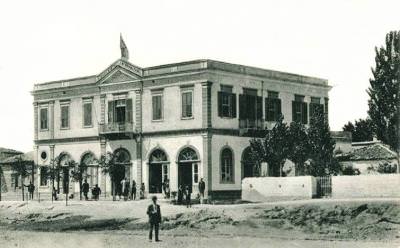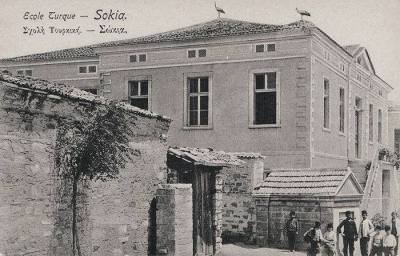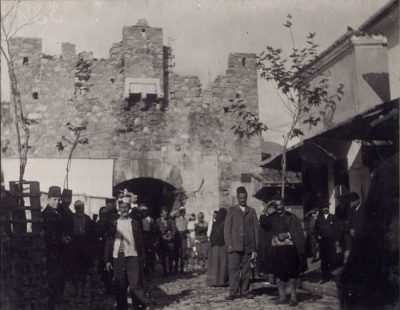Toponym
Modern Söke is identified with the ancient Greek city of Anaia (Ἄνναια, Ἄναια, Ἀναία) (also referred to as Anea, Anaea, Annaea or Annaia, Aneon, which was named after the Amazon Anaea (Ἀναία). Later, it was also called Sokia (Σώκια). Aneon is also the name of a titular see (Anaea) of the Catholic and Orthodox churches.

Greek Orthodox Population
Ecclesiastically, the Greek Orthodox population of the kaza of Söke belonged to the Diocese of Aneon (Sokia), numbering eighteen communities and 31,036 Greek Orthodox inhabitants.[1]
History
Settled for centuries before the Common Era, the region was called Aneon (Grk.: Ανέων) and was inhabited by Greeks. Stephanus of Byzantium, quoting Ephorus, mention that the tomb of the amazon Anaea was at the city. During the Peloponnesian War, some Samian exiles migrated there. In addition, Thucydides mentioned that there was a naval station, and it was near enough to annoy Samos.
In 1426 the city was captured by the Ottoman Empire Turks as the remaining capital of the sancak of Menteşe.
On 18 May 1919, Italian troops landed at Söke. The Allies were afraid that the Italian landing might provoke trouble with the Greek troops, who were near Smyrna. Although Italy and Greece were allies during WWI, their relations were not good.
After the end of World War I, fighting continued in a power struggle after the break-up of the Ottoman

Empire. In 1920, large Turkish and Arab forces were fighting against the Italian forces.
In April 1922 Italian troops were withdrawn and Greek troops entered the area. After the defeat of the Greek army in the Greco-Turkish War (1919–1922), Greek troops were withdrawn, and Turkish troops entered in September 1922. Greek inhabitants of the area fled to Greece together with the Hellenic army or they were killed by the advancing Kemalist troops. The Turkish resistance in the area was led by one Cafer Efe; a statue was erected later here to commemorate him.
During the forcible Population exchange between Greece and Turkey in the 1920s, the Greek Christian population migrated to the Greek island of Crete and more Cretan Muslims moved here.
Destruction
Diocese of Aneon (Sokia)
Before and During the First World War
“In this Diocese also (…), the same terrorism, as elsewhere, prevailed. The tobacco plantations were destroyed, inoffensive peasants were ill-used, villages blockaded and whole flocks of sheep stolen. The shepherd, Demetri, was massacred in the village of Kimitouria. The inhabitants of the communities of Tzangli, Ak-vouki, and Kimitouria were expelled to the very last man.
The majority of the inhabitants of Arvanitohori, under pretext that they were originally from the neighbouring island of Samos, were expelled. The women and old men that remained behind were ill-treated to such an extent that they were obliged to abandon their goods and leave also.
Imprisonments, oppressions, requisitions, etc., were the reasons for which the inhabitants of the following communities partially or totally dispersed, viz : Sokia [Söke], Neohori, Yeronta, Ak-keuy [Akköy], Domatia, Kelemvessi, Bayarassi, Develi-keuy [Develiköy], and Beleritch [Beleriç]. The small agglomeration of the Balkadi region, Kayas, Trianta, Develi-keuy, and Beleritch completely disappeared, owing to the mobilisation of their male population.
Alexandros, Metropolitan of Sokia, was unjustly accused of having acted contrary to the interest of the State, and his dismissal was demanded by decrees dated 8th June and 1st September, 1917. And although he was able to justify himself, he still received the order to leave Sokia and go to Smyrna. In September he was expelled by force from Sokia and sent to the Turkish village of Tsivril. In December he was allowed to make his choice of a residence in the vilayet of Broussa until the conclusion of the Armistice, when he returned to his Diocese.”[2]
Just after the Armistice, in December 1918, Muslims responded to a Greek demonstration in Söke by murdering twelve Greeks.[3]
January – August 1919: Murder and Rape
In the course of only seven months, 94 Greeks were murdered in the kaza of Söke in 1919 and despite the Italian military occupation, starting on 18 May 1919. A documentation of the Ecumenical Patriarchate lists the details:
“This district was terrorized by a gang of Turks who even after the armistice carried on their criminals work out of hostility to the Greeks inhabitants. Many were murdered, and much property was robbed. The following list or murders perpetrated in the district of Sokia from the time of the conclusion of the armistice to the end of August 1919 is a faithful picture of the terrorization and the destruction which is carried on in this district. Further information has not been received owing to the interruption of all communication between this diocese and the Patriarchate of Constantinople.
On January 9, 1919 a blind man, Neokratis Vlessas, native of Smyrna, who had a coffee – house in the railway station of Kamarya, was killed with a Mauser rifle by Turkish peasants in his house.
On the same day the women Sophoula Validou of Scalanova, servant of Neokratis Vlessas, was savagely killed with an axe by the same criminals.
On February 19 of the same year Stylianos Pandeli of Aidin [Aydın] was savagely killed with knives by four Turkish Cretans only ten minutes away from the railway station of Sokia.
On February 20, a charcoal dealer, Ioannis Xanthias of Macri, working out in the country, was killed by gendarmes.
On March 13, Manouel Lazos of Scalanova, cartercarrying a load from Sokia to Scalanova, was caught by Turkish peasants on the way and killed.
On April 11, Mihail Protoclitou of Sokia was killed by Turkish peasants at the place called ‘Your-dani’, between Sokia and Kelembesh. His body, was thrown into the Meander and after a few days it was washed out by the waters.
On April 28, Ioannis Nasos of Yeronda was killed by brigands near the Turkish village Bafi.
On May 28, Athanasios Spyroglou of Ak-keuy, a sergeant of the Greek army, visiting Sokia on leave, was killed near the Italian baraks.
On May 29, Joakim G. Derés, a notable farmer of Kelembesh, was killed together with the woman Theodora Parasskeva at the place called Gumenes by Turkish peasants.
On the same day Thrasyvoulos Bedelis of Vagarasi was killed in his farm near the village Vagarasi.
On May 30 Evangelos Kambour Andoni was killed at the farm of the brothers Gavriloglous where he was at work.
On June 2 Thomas Saroglou and Pandelis Mayrou of Sokia were killed by the well known at the place called Bounarakia near Sokia, while returning home from their work.
On the same day the Greeks Georgios Margietis Emmanuel Kanayos and Efstathios Efstathiou were killed at Tchangli by Turkish Cretans.
On June 3, Emmanuel Tsakiris, his grandson Nicolas and Nicolaos Tsamouris were savagely cut to pieces while sleeping on the meadow in the sheep-pen of the Turkish Cretan Garib Hussein.
On the same day Yannakos Boyadjis of Sokia was killed at the farm of the brothers Fourneti by the well known criminals. His body has disappeared.
On the same say Nicolas Bateskas, a notable of the village of Vagarasi was killed near the Meander by his Turkish companions, while on his way back from Sokia to Vagarasi.
On June 4, the men Athanassious Sotirakis, Ioannis Tsakourellis, Andonios Tsakourellis, Theodoros Alevras and Emanuel Kabasakaloglou were savagely cut up to pieces at the place Sari Tchai twenty minutes away from the village of Vagarasi by the invariably unknown murderers.
On the same day Pythagoras I. Katsayannis of Kelembech was killed by Turkish Cretans while on his way to Sokia.
On June 6, Evangelos Bayoukas was killed by Turkish brigands at the place Zia Bey Tchiflic [Çiflik].
On June 8, Ioannis Goumalatsos of Samos was killed by Turkish Cretans at the place Siner Boghaz [Boğaz] while at work in the tabacco field of Evrysthenis Bagtchevanakis.
On the same day Ioannis Milassianos of Sokia was killed by Turkish Cretans at the place Boghag [Boğaz?] in the tobacco field of Ionnis Kalis.
On June 10, Pandelis Pericleous of Sokia and Vassilios Andonion of Domatia, while keeping their oxen at the place Kamarya, were killed by Turkish peasants and their bodies were thrown into the Meander.
On June 12, Theodosios Mammis of Scalanova, a miller in the town of Kamarya, was killed by Zeibeks [irregulars].
On June 14, Dimitrios Kondos, of the island of Cos [Kos], a gardener, was killed at the village of Kamarya by Turkish peasants.
On the same day, the woman Anastasia Savva of Sokia was killed by Zeibeks near the bridge of the village Kamarya.
On June 16, Hadji Georgios Haloutsos of Scalanova was killed on the way from Sokia to Scalanova.
On the same day, Georgios Karabetsos of Vagarasi was killed with gun and knife at the place Giol Boghaz, twenty minutes away from the village Vagarasi.
On June 13, Michail Dal Panayoti of Sokia was killed by Turkish Cretans with a gun while at work in Evrysthenis Bagtchevanakis tobacco field.
On the same day, Athanasios Tombanis and Athanasios Parachou of Bagarasi were killed in the outskirts of the village of Kamarya near the farm of the brothers D. Fotiadis.
On June 19, Emmanuel Grammaticos, his wife Evgenia, and their granddaughters Stavritsa and Yannoula were cut to pieces, naked, in their sheep-pen near the Turkish village Oz Bashi [Özbaşı], by Turkish peasants.
On June 23, Panayotis Manetakis and the women Yannoula Manetaki and Sofia Manetaki were killed by Zeibeks at the place Oz Bashi, while at work in the farm of a Turk.
On June 24, twenty Greeks, named: Dim. Papa Alex. Spahis, Georgios Spahis, Hadji Hippocratis, Hadji Andoniou, Evangelia Hadji Hippocratous, Evangelos M. Toutoukis, Manouel Nic. Koulas, Hadji Anagnostou, Stelios Dim. Vardicon, Panayotis Apostolou, Patros Andon. Dimoglou, Constantinos Patrou, Anastasia Patrou, Evangelia Criticou, Maria 8terhiou, Theophano Gomniotou, Pagoni Vovou, loannis Alex. Lekatis, the monk Meletios of Patmos, Dimitrios Papa Iconomou and Kyriakos Polichroniou, while at work in the tobacco field of Papa Alexandras Spahis were killed at midday by thirty Turkish horsemen coming from the village Ak Bourga near the tobacco field and from other neighbouring villages Sari Kemer, Palatia and others. The woman Chryssi Panayotou was severely wounded.
On June 25, Marcos Vlachos, Evangelos Koulias and Manouel Nikitoglou were killed outside the village of Domatia by the same scoundrels.
On the same day Dimitrios Arapis of Vagarasi was killed in the neighbourhood of Varka Meandrou while working at the farm of a Turk.
On June 26 Georgios Karaiskos of Vagarasi was killed at the place ‘Islam Vagarasi’, while at work in the farm of the Turk Omer [Ömer] aga.
On the same day Georgios Tsipnis of Vagarasi was killed by Turkish peasants outside the village of Vagarasi.
On June 27, Ioannis Rodios of Vagarasi was killed by Turkish peasant outside Vagarasi.
On July 3, Emmanuel Masakas of Sokia was’ killed by Turkish Cretans at Deirmen Dere while at work in the mills there.
On July 3, Sotirios Kirkitzotis of Kelembesh, working in the sheep-pen of Xenophon Anastasiadis was killed by Turks from the village of Oz Bashi, about an hour off from Kelembesh. .
On July 11, Aslanis Vasiloglou of Sokia was killed by gendarmes, at the place Kapakli Bounar near Kelembesh.
On July 15, Constantinos Melembiscou was killed in his sheep-pen by Turks from the village of Oz Bashi.
On July 22, Constantinos Xiropsomis and his wife Morphi, of Kelembesh, were killed at the village of Koibeni, an hour away from Kelembesh by a Turkish sergeant and gendarmes, whose names are unknown.
On July 22, the women Calliopi Argyriou, Urania Tsardoulia, Despina Tsardoulia, Maria Spanou, Argyro Spanou, and the ten year old boy Georgios Tsardoulias were carried off by Turkish Cretans from the tobacco fields of Kerim Arnaout, where they were at work, and they were killed after being violated.
On August 1, Constantinos Vikos of Neohori was killed in the country by Circassians at a place only half an hour distant from the village. The same criminals badly wounded in the thigh a widow from Neohori, Efthymia Theodosiou.
On August 12, Georgios N. Hadji lliadis, while returning with two Armenians from Scalanova to Sokia, was killed with his companions at the place Kranta.
On August 14, Constantinos Zambioglou of Kelembesh carrying sheep to Kelembesh and escorted by two Turkish gendarmes was killed at the place Oz Bashi.
On August 27, Georgios N. Tsangliotou, loannis K. Vouta and Stylianos Hiotatis of Sokia, who had gone to cut wood, were killed by Turkish Cretans at the place Karaoghlan, an hour off from Sokia.
On August 23, Grigorios Kambouroglou of Neohori, working in the sheep-pen of the Turkish Cretan Kior Ali, in Zia Bey’s farm, disappeared, and no trace of his body has been found.
On the same day, Demosthenis Philippou of Cyprus was killed by Turkish peasants while on the way from Sokia to Scalanova.
On August 30, Georgios Zeibekis and his son Panayis, who had gone to the village of Oz Bashi to search for their robbed cattle, were both killed by the peasants of that village.”[4]
1920
“In Sokia the officials confiscated the houses and shops of many Christians. In Nov. 1920 two Greeks going from Kelebek to Sokia were killed by Turks. In December the authorities at Sokia arrested Petrides of Akka-keuy and made away with him. Only Christians are forbidden to travel from the interior to Smyrna.”[5]
